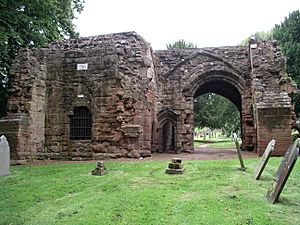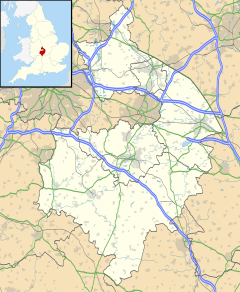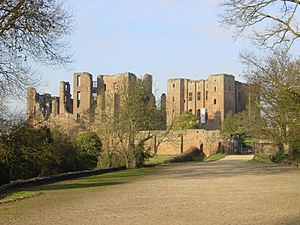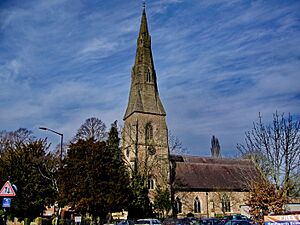Kenilworth facts for kids
Quick facts for kids Kenilworth |
|
|---|---|
 Clock tower at the junction of The Square, Smalley Place and Abbey End |
|
| Population | 22,538 (2021 Census) |
| OS grid reference | SP2971 |
| Civil parish |
|
| District |
|
| Shire county | |
| Region | |
| Country | England |
| Sovereign state | United Kingdom |
| Post town | KENILWORTH |
| Postcode district | CV8 |
| Dialling code | 01926 |
| Police | Warwickshire |
| Fire | Warwickshire |
| Ambulance | West Midlands |
| EU Parliament | West Midlands |
| UK Parliament |
|
| Website | https://www.kenilworthweb.co.uk/ |
Kenilworth is a lively market town in Warwickshire, England. It's about 6 miles (10 km) southwest of Coventry and 5 miles (8 km) north of Warwick. The town sits near Finham Brook, a small river that flows into the River Sowe. In 2021, about 22,538 people lived here. Kenilworth is famous for the amazing ruins of Kenilworth Castle and Kenilworth Abbey.
Contents
History of Kenilworth
Early Times and Medieval History

Kenilworth was first mentioned in the Domesday Book in 1086, where it was called Chinewrde. This shows it was already a settlement back then.
In 1122, a man named Geoffrey de Clinton started building an Augustinian priory here. Around the same time, he also began building Kenilworth Castle. The priory became a bigger church, an abbey, in 1450. However, in the 1530s, during the time when King Henry VIII closed down many monasteries, Kenilworth Abbey was also shut down. Today, only a few walls and a storage barn from the original abbey remain.
Kenilworth played a big part in England's history during the Middle Ages. From June to December 1266, Kenilworth Castle faced a huge six-month siege. This happened during the Second Barons' War. Forces loyal to Simon de Montfort were trapped inside the castle by Prince Edward's army. This siege is thought to be the longest in medieval English history! Even with many attempts, the castle's defenses were too strong.
While the siege was happening, King Henry III held a special meeting, called a Parliament, in Kenilworth. This meeting created the Dictum of Kenilworth. It was a document that offered peace terms to end the war between the barons and the king. At first, the barons didn't want to agree. But eventually, hunger and sickness forced them to surrender and accept the terms.
During the Wars of the Roses in the 1400s, Kenilworth Castle was an important base for the Lancastrian side. King Henry VI and his wife, Margaret of Anjou, spent a lot of time here.
Queen Elizabeth I visited Robert Dudley, 1st Earl of Leicester at Kenilworth Castle several times. Her last visit was in 1575. Dudley put on amazing shows and banquets for the Queen. These parties cost a lot of money, about £1,000 a day, which was a huge amount back then! They even had fireworks.
Near the castle, there's a group of old thatched cottages called 'Little Virginia'. A local story says that the first potatoes brought to England by Sir Walter Raleigh from the New World were planted here. However, historians today think this is unlikely. They suggest the name might have come from early settlers returning from Virginia in America.
Later Centuries and Modern Growth
During the English Civil War, Kenilworth Castle was taken over by Parliament's army. After the war ended, in 1649, Parliament ordered the castle's defenses to be destroyed. This is why the castle became a ruin.
In 1778, the Kenilworth windmill was built. Later, in 1884, it was changed into a water tower. A big water tank was added to the top where the sails used to be. It supplied water to the town until 1939 and stopped being used in 1960. It's still a well-known local landmark and is now a private home.
In the early 1800s, Kenilworth was known for making horn combs. This industry was at its busiest in the 1830s.
The town changed a lot when the railway arrived in 1844. The London and Birmingham Railway opened a line from Coventry to Leamington, which included Kenilworth railway station. The station was rebuilt in 1884. The railway caused the town to grow south, away from the castle, closer to the station. Business people from Birmingham and Coventry came and built homes and shops near the railway. The railway also brought new industries like tanning (making leather), brick making, and chemicals. It also helped Kenilworth's market gardening grow, making the town known for crops like tomatoes and strawberries.
As the town grew, a second Church of England parish church, St John's, was built in 1851–1852. By the 1870s, Kenilworth's population was over 4,000 people.
In 1869, a local engineer named Edward Langley Fardon showed off the first bicycle with wire-spoked wheels and rubber tires. He rode it from Warwick Road to Leek Wootton.
During World War II, on November 21, 1940, a German aircraft dropped two bombs on Kenilworth. These caused huge explosions in the Abbey End area, destroying many buildings. Sadly, 25 people died, and 70 more were hurt. The damaged part of the town was rebuilt in the 1960s.
In 1961, the Kenilworth Society was formed. This group wanted to protect old 17th-century cottages in Bridge Street. The Society works to keep Kenilworth's special character and make sure it is preserved.
The original Kenilworth railway station closed in 1965. However, a new station was built and finally reopened in 2018!
Geography of Kenilworth
Kenilworth has several smaller areas, or suburbs, like Borrowell, Castle Green, and Park Hill. The town has good ways to get to nearby cities like Coventry, Warwick, Leamington Spa, and Birmingham.
Things to Do and See
The main shopping areas in Kenilworth are around Warwick Street, Abbey End, and Talisman Square. Talisman Square was updated in 2008 and now includes a new Waitrose supermarket. Kenilworth has been a Fairtrade Town since 2007, meaning it supports fair prices for goods. The town's public library was also updated in 2021. The Cross, a local pub-restaurant, even received a special award called a Michelin star in 2015!
Near the town center is Abbey Fields, a large public park that covers about 68 acres (28 hectares). It's in the valley of Finham Brook. In Abbey Fields, you can find the ruins of Kenilworth Abbey and St Nicholas Church. The park also has fun things like a swimming pool, a lake, a children's play area, and walking trails.
There are other green spaces too, like Kenilworth Common, a historic area of common land covering 30 acres (12 hectares). Parliament Piece, a field and nature reserve, is where King Henry III supposedly held a Parliament in 1266.
Important Landmarks
In the middle of Kenilworth, there's a cool water feature called the Millennium Globe. It's a Kugel ball that floats on water.
Kenilworth's clock tower is a very important local landmark. It was built in 1906–1907 by a kind local person, George Marshall Turner, to remember his wife. It stands in a roundabout in the town center. The top of the tower was badly damaged during World War II bombing in 1940. It was fully repaired in the 1970s.
Local Government
Kenilworth has three levels of local government: the Kenilworth Town Council, Warwick District Council, and Warwickshire County Council. The Town Council works from Jubilee House in the town center.
Since 2010, Kenilworth has been part of the Kenilworth and Southam area for national elections.
Transport in Kenilworth
Kenilworth railway station is on the line between Coventry and Leamington Spa. The original station closed in 1965, but a new one opened in April 2018! West Midlands Trains runs services from here to Nuneaton, Coventry, and Leamington Spa.
The A46 bypass road opened in 1974, making it easier to travel around. Birmingham Airport and major motorways like the M6, M42, and M40 are all within about 12 miles (19 km) of the town.
Local Media
For local news and TV, Kenilworth gets programmes from BBC Midlands and ITV Central.
There are several local radio stations, including BBC CWR and Radio Abbey, which is a community station. The town also has two local newspapers: the Kenilworth Weekly News and the Leamington Observer.
Sports in Kenilworth
Kenilworth has many sports clubs for different interests:
- Football: Kenilworth Town FC and Kenilworth Wardens FC are the local football clubs.
- Rugby: Kenilworth RFC is the town's rugby union club. They have teams for all ages.
- Tennis, Squash, and Croquet: The Kenilworth Tennis, Squash and Croquet Club has courts for these sports.
- Cricket: Kenilworth has two cricket clubs: Kenilworth Wardens and Kenilworth Cricket Club.
- Running: Kenilworth Runners is a club for runners of all ages and abilities.
- Orienteering: Octavian Droobers is the local orienteering club, which uses maps of Abbey Fields and Kenilworth Common for events.
- Cycling: Kenilworth Wheelers meets for road rides and training.
- Swimming: Abbey Fields Swimming Pool has indoor and outdoor pools. It's home to Kenilworth Swimming Club.
- Golf: Kenilworth Golf Club has an 18-hole course.
Two Castles Run
The Two Castles Run is a popular running event that started in 1983. It's a fun run between Warwick Castle and Kenilworth Castle. It has grown a lot, with 3,000 people taking part in 2010. By 2012, all 4,000 spots were sold out in just 25 hours! The race is organized every June by Kenilworth Rotary Club.
Arts and Culture
Theatres
The Talisman Theatre and Arts Centre started in 1942. It moved to its current building in 1969 and has 156 seats. The Talisman puts on about 9 main shows each year, including performances by the Talisman Youth Theatre. They also have "Fringe" nights and a monthly cinema night.
The Priory Theatre was founded in 1932. It uses an old chapel building that was turned into a 119-seat theatre in 1945–1946. It was damaged by fire in 1976 but was rebuilt and reopened in 1978.
Kenilworth Arts Festival
The first Kenilworth Festival was held way back in 1935. After a long break, it was brought back in 2005. Since 2015–16, it's been known as 'Kenilworth Arts Festival' and has a new focus. The festival took place again in September 2019.
Education
Kenilworth is close to the University of Warwick, which is about 2.5 miles (4 km) north.
The main secondary school in town is the Kenilworth School and Sixth Form. There are also several schools for younger children.
Famous People from Kenilworth
Many interesting people have connections to Kenilworth:
- Henry III of England (1207–1272) was involved with the Dictum of Kenilworth.
- Edward II of England (1284–1327) was held prisoner at Kenilworth Castle.
- Robert Dudley, 1st Earl of Leicester (1532 or 1533–1588) lived at Kenilworth Castle.
- Sir Walter Scott (1771–1832) wrote a famous novel called Kenilworth in 1821, which helped make the castle ruins popular.
- John Sumner (1780–1862), who became the Archbishop of Canterbury, was born in Kenilworth.
- Edward Langley Fardon (1839–1926), an inventor, lived in Kenilworth.
- Sir Arthur Sullivan (1842–1900) wrote a musical piece called The Masque at Kenilworth.
- Alec Issigonis (1906-1988), who designed the famous Morris Minor and Austin Mini cars, lived and worked in Kenilworth.
- Basil Heatley (1933–2019) was an Olympic silver medallist in marathon running, born in Kenilworth.
- Andrew Davies (born 1936), a novelist and screenwriter, lives in Kenilworth.
- Tim Flowers (born 1967 in Kenilworth) is a former professional football goalkeeper who played for England.
- Sarah-Jane Perry (born 1990), a professional international squash player, went to Kenilworth School.
Twin Towns
Kenilworth has special "twin town" friendships with other towns around the world:
- Bourg-la-Reine, France
- Eppstein, Germany
- Roccalumera, Italy
Kenilworth also has friendship links with:
- Bo, Sierra Leone
- Uyogo, Tanzania
See also
 In Spanish: Kenilworth para niños
In Spanish: Kenilworth para niños










